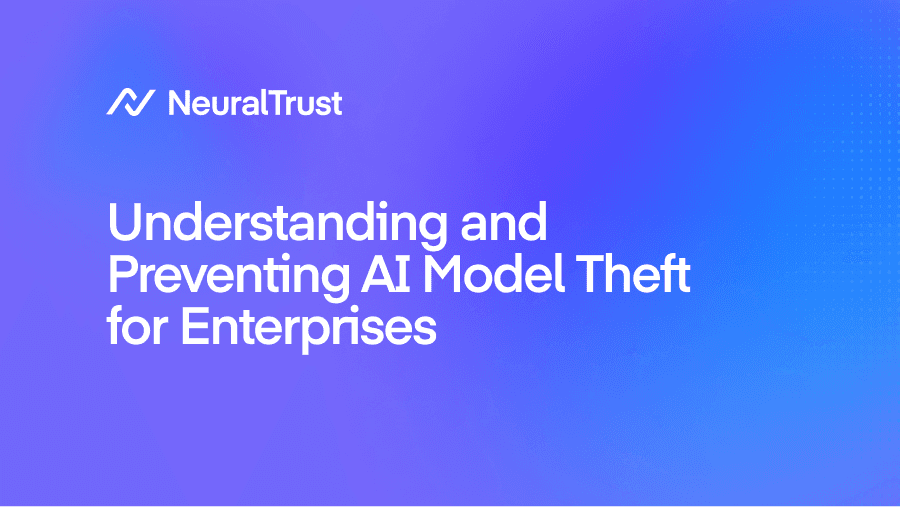Understanding and Preventing AI Model Theft: Strategies for Enterprise

As LLMs revolutionize industries, they also face growing threats that target their proprietary value. Among these risks, AI model theft has emerged as a critical challenge for enterprises. The ability to replicate or extract these models through adversarial techniques poses serious threats to intellectual property, competitive advantage, and operational integrity.
In this post, we explore how AI model theft occurs, its implications for enterprises, and actionable strategies to safeguard these valuable assets. Be sure to also check our post on How to Secure Large Language Models from Adversarial Attacks, and our comprehensive guide on New Risks in the Era of Generative AI, for an in-depth analysis of the threat landscape.
What Is AI Model Theft?
AI model theft, often referred to as model extraction, is an adversarial technique where attackers exploit repeated queries to replicate or duplicate a model's functionality. By analyzing the responses generated by an LLM, malicious actors reverse-engineer a model, effectively stealing its intellectual property without incurring the costs of training or development.
How It Happens:
- Query Overloading: Attackers send thousands of prompts to extract patterns and outputs that reveal the underlying model’s architecture and parameters.
- API Exploitation: Many enterprises expose their LLMs through APIs, creating a vulnerable surface for exploitation by determined adversaries.
- Insider Threats: Employees or collaborators with access to internal tools can unintentionally or maliciously leak sensitive model details.
Why AI Model Theft Is a Serious Concern
AI model theft strikes at the core of an enterprise's innovation and competitiveness, undermining valuable investment in research, development, and implementation. The consequences of such theft extend far beyond financial losses, impacting operational stability, market positioning, and stakeholder trust.
Key Implications:
- Intellectual Property Loss: Enterprises invest millions in developing and training LLMs. Theft of these assets allows competitors or bad actors to replicate capabilities, eroding competitive advantage.
- Economic Impact: Replicating an LLM from stolen data eliminates the significant financial barriers of model training. This reduces market differentiation and can drive down profitability.
- Reputation and Trust: A stolen or compromised model may lead to unauthorized usage under the enterprise's name, damaging customer trust and brand reputation.
- Security Breaches: Theft of proprietary LLMs can open doors to further cybersecurity risks, such as data manipulation, misinformation generation, or malicious outputs under the guise of enterprise systems.
Strategies to Prevent AI Model Theft
Preventing AI model theft requires a layered security approach that combines technical solutions, robust governance, and proactive monitoring. Below are six actionable strategies:
Implement API Access Controls
Restrict access to APIs by implementing robust authentication mechanisms such as API keys, OAuth, or JWT, ensuring only authorized users interact with your models. Strengthen this defense with rate limiting to prevent query overloading, reducing the likelihood of model extraction and safeguarding performance.
Integrate Model Watermarking
Embed invisible digital watermarks into your AI outputs to trace and identify unauthorized usage while maintaining model functionality. Choose advanced watermarking techniques that remain resilient against tampering and can serve as legal evidence if theft occurs. ([A Playbook for Securing AI Model Weights])(https://www.rand.org/pubs/research_briefs/RBA2849-1.html)
Use Differential Privacy
Incorporate controlled noise into model outputs to obscure sensitive parameters, ensuring adversaries cannot infer proprietary data through repeated queries. Optimize this approach to balance privacy protection with the accuracy and reliability needed for legitimate use cases.
Deploy AI Gateways
Centralize your security strategy with an AI gateway that filters, monitors, and secures all interactions with your models. Enhance protection with integrated features like real-time anomaly detection, prompt moderation, and adaptive access controls for a holistic defense against diverse threats.
Adopt Adversarial Testing
Conduct simulated model extraction attacks in controlled environments to proactively identify vulnerabilities in your systems. Continuously update your testing protocols to address the latest attack vectors, ensuring your LLMs remain robust and secure over time.
Foster Organizational Awareness
Educate employees on the risks associated with AI model theft, emphasizing the value of intellectual property and the role everyone plays in its protection. Establish comprehensive policies that regulate access and behavior, mitigating both insider and external threats to your AI assets.
Emerging Trends in AI Model Theft Prevention
As the AI landscape evolves, so do the tactics used by adversaries. Staying ahead of these threats requires not only robust security measures but also a forward-looking approach. Here are some emerging trends in AI model theft prevention that enterprises should watch closely:
- Federated Learning for Decentralized Training: Reduces exposure to sensitive parameters by training models across multiple devices without sharing raw data.
- Blockchain for Enhanced Model Security: Provides an immutable record of ownership and access, ensuring every interaction is traceable and secure.
- Advanced Threat Intelligence Integration: Leverages continuously updated intelligence platforms to counter emerging adversarial techniques.
- Zero-Trust Architecture for AI Systems: Minimizes reliance on implicit trust by authenticating every interaction, reducing risks from insider and external threats.
- AI-Powered Intrusion Detection: Employs models trained on adversarial patterns to detect and respond to suspicious activities in real time.
Conclusion: Prioritize AI Model Security
AI model theft poses a serious threat to enterprises investing in LLM innovation. By understanding the risks and implementing robust strategies, organizations can protect their intellectual property, maintain trust, and preserve their competitive edge.
Secure Your AI Ecosystem with NeuralTrust
At NeuralTrust, we provide advanced solutions to protect your AI assets from model theft and other adversarial threats. From AI gateways to real-time monitoring tools, our platform is designed to safeguard your systems and ensure compliance with global standards.



